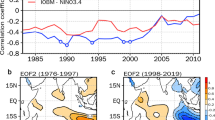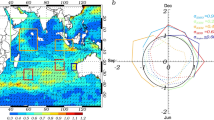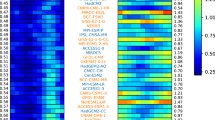Abstract
El Niño-Southern Oscillation (ENSO) consists of irregular episodes of warm El Niño and cold La Niña conditions in the tropical Pacific Ocean1, with significant global socio-economic and environmental impacts1. Nevertheless, forecasting ENSO at lead times longer than a few months remains a challenge2,3. Like the Pacific Ocean, the Indian Ocean also shows interannual climate fluctuations, which are known as the Indian Ocean Dipole4,5. Positive phases of the Indian Ocean Dipole tend to co-occur with El Niño, and negative phases with La Niña6,7,8,9. Here we show using a simple forecast model that in addition to this link, a negative phase of the Indian Ocean Dipole anomaly is an efficient predictor of El Niño 14 months before its peak, and similarly, a positive phase in the Indian Ocean Dipole often precedes La Niña. Observations and model analyses suggest that the Indian Ocean Dipole modulates the strength of the Walker circulation in autumn. The quick demise of the Indian Ocean Dipole anomaly in November–December then induces a sudden collapse of anomalous zonal winds over the Pacific Ocean, which leads to the development of El Niño/La Niña. Our study suggests that improvements in the observing system in the Indian Ocean region and better simulations of its interannual climate variability will benefit ENSO forecasts.
This is a preview of subscription content, access via your institution
Access options
Subscribe to this journal
Receive 12 print issues and online access
$259.00 per year
only $21.58 per issue
Buy this article
- Purchase on Springer Link
- Instant access to full article PDF
Prices may be subject to local taxes which are calculated during checkout




Similar content being viewed by others
References
McPhaden, M. J., Zebiak, S. E. & Glantz, M. H. ENSO as an integrating concept in Earth science. Science 314, 1740–1745 (2006).
Barnston, A. G., Glantz, M. H. & He, Y. Predictive skill of statistical and dynamical climate models in SST forecasts during the 1997–98 El Niño episode and the 1998 La Niña onset. Bull. Am. Meteorol. Soc. 80, 217–243 (1999).
Jin, E. K. et al. Current status of ENSO prediction skill in coupled ocean–atmosphere models. Clim. Dynam. 31, 647–664 (2008).
Saji, N. H., Goswami, B. N., Vinayachandran, P. N. & Yamagata, T. A dipole mode in the tropical Indian Ocean. Nature 401, 360–363 (1999).
Webster, P. J., Moore, A. M., Loschnigg, J. P. & Leben, R. R. Coupled oceanic–atmospheric dynamics in the Indian Ocean during 1997–98. Nature 401, 356–360 (1999).
Yamagata, T. et al. in Earth’s Climate: The Ocean-Atmosphere Interaction (eds Wang, C., Xie, S.-P. & Carton, J. A.) 189–211 (Geophysical Monograph Series, Vol. 147, American Geophysical Union, 2004).
Annamalai, H., Xie, S.-P., McCreary, J.-P. & Murtugudde, R. Impact of Indian Ocean sea surface temperature on developing El Niño. J. Clim. 18, 302–319 (2005).
Behera, S. K. et al. A CGCM study on the interaction between IOD and ENSO. J. Clim. 19, 1608–1705 (2006).
Luo, J.-J. et al. Interaction between El Niño and Extreme Indian Ocean Dipole. J. Clim. 10.1175/2009JCLI3104.1 (2010).
Bjerknes, J. A possible response of the atmospheric Hadley circulation to anomalies of ocean temperature. Tellus 18, 820–829 (1966).
Wyrtki, K. Water displacements in the Pacific and the genesis of El Niño cycles. J. Geophys. Res. 90, 7129–7132 (1985).
Meinen, C. S. & McPhaden, M. J. Observations of warm water volume changes in the equatorial Pacific and their relationship to El Niño and La Niña. J. Clim. 13, 3551–3559 (2000).
Jin, F.-F. An equatorial ocean recharge paradigm for ENSO. Part I: Conceptual model. J. Atmos. Sci. 54, 811–829 (1997).
Annamalai, H. et al. Coupled dynamics over the Indian Ocean: Spring initiation of the zonal mode. Deep-Sea Res. II 50, 2305–2330 (2003).
McPhaden, M. J., Zhang, X., Hendon, H. H. & Wheeler, M. C. Large scale dynamics and MJO forcing of ENSO variability. Geophys. Res. Lett. 33, L16702 (2006).
Yamagata, T. & Masumoto, Y. A simple ocean–atmosphere coupled model of the origin of a warm ENSO event. Phil. Trans. R. Soc. Lond. A 329, 225–236 (1989).
Wang, C., Weisberg, R. H. & Virmani, J. I. Western Pacific interannual variability associated with the El Niño-southern oscillation. J. Geophys. Res. 104, 5131–5149 (1999).
Kug, J.-S. & Kang, I.-S. Interactive feedback between ENSO and the Indian Ocean. J. Clim. 19, 1784–1801 (2006).
Clarke, A. J. & Van Gorder, S. Improving El Niño prediction using a space–time integration of Indo-Pacific winds and equatorial Pacific upper ocean heat content. Geophys. Res. Lett. 30, 1399 (2003).
Webster, P. J. The annual cycle and the predictability of the tropical coupled ocean–atmosphere system. Meteorol. Atmos. Phys. 56, 33–55 (1995).
Picaut, J., Masia, F. & du Penhoat, Y. An advective-reflective conceptual model for the oscillatory nature of the ENSO. Science 277, 663–666 (1997).
Kessler, W. S., McPhaden, M. J. & Weikmann, K. M. Forcing of intraseasonal Kelvin waves in the equatorial Pacific. J. Geophys. Res. 100, 10613–10631 (1995).
Lengaigne, M., Boulanger, J.-P., Menkes, C., Delecluse, P. & Slingo, J. in Earth Climate: The Ocean-Atmosphere Interaction 49–69 (Geophysical Monograph Series, Vol. 147, American Geophysical Union, 2004).
Zhang, C. Madden-Julian Oscillation. Rev. Geophys. 43, RG2003 (2005).
Seiki, A. & Takayabu, Y. N. Westerly wind bursts and their relationship with intraseasonal variations and ENSO. Part I: Statistics. Mon. Weath. Rev. 135, 3325–3345 (2007).
Eisenman, I., Yu, L. & Tziperman, E. Westerly wind bursts: ENSO’s tail rather than the dog? J. Clim. 18, 5224–5238 (2005).
Izumo, T. et al. Low and high frequency Madden-Julian oscillations in Austral Summer—Interannual variations. Clim. Dynam. 10.1007/s00382-009-0655-z (2010).
Yu, J.-Y. Enhancement of ENSO’s persistence barrier by biennial variability in a coupled atmosphere-ocean general circulation model. Geophys. Res. Lett. 32, L13707 (2005).
Luo, J.-J., Masson, S., Behera, S. & Yamagata, T. Experimental forecasts of the Indian Ocean Dipole using a coupled OAGCM. J. Clim. 20, 2178–2190 (2007).
McPhaden, M. J. et al. RAMA: The research moored array for African–Asian–Australian monsoon analysis and prediction. Bull. Am. Meteorol. Soc. 90, 459–480 (2009).
Acknowledgements
T.I. would like acknowledge and thank his PhD advisor, J. Picaut, who inspired him with knowledge and enthusiasm. P.J. Webster provided constructive comments, which helped us in improving an earlier version of the manuscript. We would like to thank JAMSTEC/RIGC and NIO (India) for their support and hospitality, and NOAA/PMEL for making TAO data and the FERRET analysis tool available. This work was financially supported by JSPS, IRD, the University of Tokyo and IRD/CNRS.
Author information
Authors and Affiliations
Contributions
T.I. carried out most of the analyses and shallow-water experiments with support and advice from J.V. and M.L. T.I., J.V. and M.L. wrote most of the text. C.d.B.M. helped in collecting the data. S.K.B. provided the shallow-water model. J.-J.L. carried out the SINTEX-F model experiments and hindcasts. All authors contributed to the material in this paper through numerous discussions.
Corresponding author
Ethics declarations
Competing interests
The authors declare no competing financial interests.
Supplementary information
Supplementary Information
Supplementary Information (PDF 4165 kb)
Rights and permissions
About this article
Cite this article
Izumo, T., Vialard, J., Lengaigne, M. et al. Influence of the state of the Indian Ocean Dipole on the following year’s El Niño. Nature Geosci 3, 168–172 (2010). https://doi.org/10.1038/ngeo760
Received:
Accepted:
Published:
Issue Date:
DOI: https://doi.org/10.1038/ngeo760
This article is cited by
-
Artificial intelligence predicts normal summer monsoon rainfall for India in 2023
Scientific Reports (2024)
-
Boosting effect of strong western pole of the Indian Ocean Dipole on the decay of El Niño events
npj Climate and Atmospheric Science (2024)
-
How does the North Pacific Meridional Mode affect the Indian Ocean Dipole?
Climate Dynamics (2024)
-
Joint impacts of winter North Pacific Oscillation and early spring Aleutian Low intensity on the following winter ENSO
Climate Dynamics (2024)
-
Attributing interdecadal variations of southern tropical Indian Ocean dipole mode to rhythms of Bjerknes feedback intensity
Climate Dynamics (2024)



